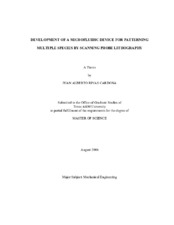| dc.description.abstract | Scanning Probe Lithography (SPL) is a versatile nanofabrication platform that leverages
microfluidic “ink” delivery systems with Scanning Probe Microscopy (SPM) for generating
surface-patterned chemical functionality on the sub-100 nm length scale. One of the prolific SPL
techniques is Dip Pen Nanolithography™ (DPN™). High resolution, multiplexed registration
and parallel direct-write capabilities make DPN (and other SPL techniques) a power tool for
applications that are envisioned in micro/nano-electronics, molecular electronics, catalysis,
cryptography (brand protection), combinatorial synthesis (nano-materials discovery and
characterization), biological recognition, genomics, and proteomics. One of the greatest
challenges for the successful performance of the DPN process is the delivery of multiple inks to
the scanning probe tips for nano-patterning. The purpose of the present work is to fabricate a
microfluidic ink delivery device (called “Centiwell”) for DPN (and other SPL) applications. The
device described in this study maximizes the number of chemical species (inks) for
nanofabrication that can be patterned simultaneously by DPN to conform the industrial standards
for fluid handling for biochemical assays (e.g., genomic and proteomic). Alternate applications
of Centiwell are also feasible for the various envisioned applications of DPN (and other SPL
techniques) that were listed above. The Centiwell consists of a two-dimensional array of 96 microwells that are bulk micromachined
on a silicon substrate. A thermoelectric module is attached to the back side of the silicon
substrate and is used to cool the silicon substrate to temperatures below the dew point. By
reducing the temperature of the substrate to below the dew point, water droplets are condensed in
the microwell array. Microbeads of a hygroscopic material (e.g., poly-ethylene glycol) are
dispensed into the microwells to prevent evaporation of the condensed water. Furthermore, since
poly-ethylene glycol (PEG) is water soluble, it forms a solution inside the microwells which is
subsequently used as the ink for the DPN process. The delivery of the ink to the scanning probe
tip is performed by dipping the tip (or multiple tips in an array) into the microwells containing
the PEG solution.
This thesis describes the various development steps for the Centiwell. These steps include the
mask design, the bulk micromachining processes explored for the micro-fabrication of the
microwell array, the thermal design calculations performed for the selection of the commercially
available thermoelectric coolers, the techniques explored for the synthesis of the PEG
microbeads, and the assembly of all the components for integration into a functional Centiwell.
Finally, the successful implementation of the Centiwell for nanolithography of PEG solutions is
also demonstrated. | en |


